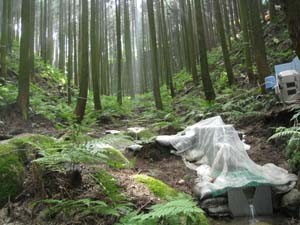When Trees Aren’t ‘Green’

Photo provided by Masaaki Chiwa. Testing equipment used to measure nitrogen runoff in Japanese cedar plantation.
Most of us don’t consider forests a source of pollution. As natural bodies, they should be good for the environment. But a recent study in Japan shows that older cedar and cypress plantations are causing as much pollution as a poorly managed agricultural field or urban setting.
Masaaki Chiwa is the lead author of the study and an assistant professor at Kyushu University in Japan. According to Chiwa, the pollution is not the fault of the trees. It’s the management of the plantations. In Japan, as in other countries, natural forests usually play a significant role in maintaining water quality.
“Many Japanese cedar and Japanese cypress plantations were established in the 1950s and 1960s—60% of those on private land,” according to Chiwa. “These are not natural forests; they were meant for commercial purposes.”
At the time of their planting, there was a short supply of these trees. However, an increase in imports of other woods has affected prices of Japanese cedar and cypress and led to the decline in active plantation management. The result was overcrowded land with aging trees and little to no undergrowth.
These older plantations are now a source of non-point nitrogen pollution according to the study. “Point” pollution comes from a single location; “non-point” pollution comes from a more diffuse area, such as these plantations. The nitrogen is flowing from the plantations during rainfalls or snowmelts into nearby bodies of water, causing algae blooms.
Where does all this nitrogen come from? Just like in a natural forest, needles fall from the aging trees and accumulate on the plantation floor. This is part of Mother Nature’s way of recycling nutrients. Earthworms and soil microbes decompose the needles and return the nutrients to the soil. Younger growth nearby finishes the process and takes up the nutrients.
However, the age of the trees in these plantations means they are growing more slowly. They use fewer nutrients from the soil than younger trees, including nitrogen. Furthermore, crowding of the trees means there is too much shade to encourage new growth. This prevents a new, healthy understory that would use the nitrogen (and other nutrients) from the soil. Because the plants are not using the nutrients, the nutrients form runoff heading to the streams.
Since cedar and cypress plantations account for 30% of the forestland in Japan, the findings of this study are significant. Chiwa and his team would recommend that the plantation land be thinned and returned to a more natural forest state.
As part of another project, some landowners thinned plantations in 2012. To verify that the thinning will reduce runoff, Chiwa and his team are now measuring the amount of nitrogen flowing from the plantations. “We have been measuring water quality to evaluate the effect of forest thinning on water quality including nitrogen loss.”
Hopefully, better management will bring these plantations back to a less-crowded, more natural state, and restore their ability to clean water rather than pollute it.
The study was published in the Journal of Environmental Quality.
Contact Information
Susan Fisk
Public and Science Communications Director
sfisk@sciencesocieties.org
Phone: 608-273-8091
Media Contact
More Information:
http://www.science.doe.govAll latest news from the category: Ecology, The Environment and Conservation
This complex theme deals primarily with interactions between organisms and the environmental factors that impact them, but to a greater extent between individual inanimate environmental factors.
innovations-report offers informative reports and articles on topics such as climate protection, landscape conservation, ecological systems, wildlife and nature parks and ecosystem efficiency and balance.
Newest articles

NASA: Mystery of life’s handedness deepens
The mystery of why life uses molecules with specific orientations has deepened with a NASA-funded discovery that RNA — a key molecule thought to have potentially held the instructions for…

What are the effects of historic lithium mining on water quality?
Study reveals low levels of common contaminants but high levels of other elements in waters associated with an abandoned lithium mine. Lithium ore and mining waste from a historic lithium…

Quantum-inspired design boosts efficiency of heat-to-electricity conversion
Rice engineers take unconventional route to improving thermophotovoltaic systems. Researchers at Rice University have found a new way to improve a key element of thermophotovoltaic (TPV) systems, which convert heat…



